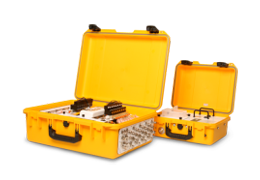Printable PDF: Tips for Extending Battery Life for Survey or Single Chamber Long-Term Measurements
Tips for extending battery life for survey or single-chamber long-term measurements.
Researchers may need to collect Soil CO2 Flux measurements over an extended period of time. In either “Survey” or “Single Chamber Long-Term” mode, conserving power is always an issue. LI-COR has developed a few tips on how to extend battery life in both configurations.
Using the LI-8100 System for Survey Measurements with a Survey Chamber (8100-102 or 8100-103)
When using the LI-8100 Automated Soil CO2 Flux System as a portable instrument to make attended measurements at multiple soil collar locations, a user can utilize the 6400-03 Rechargeable Battery. This battery provides about 3 hours of use if 10 measurements per hour are taken. However, users may want to sample across a larger amount of soil collars over a longer duration of time. LI-COR typically recommends having two or three of the 6400-03 batteries available to swap when battery voltages drain. An easy solution is to simply obtain additional 6400-03 Batteries. While this will add another component that would need to be brought to a measurement site, it allows the user to swap out batteries during measurement periods.
Using the LI-8100 System for Long-Term Measurements with a Single Chamber (8100-101/8100-104):
When using the LI-8100 Automated Soil CO2 Flux Analyzer to collect unattended measurements using a Long-Term Chamber for an extended period of time, the 6400-03 battery is not an ideal battery solution due to its size. A different type of battery should be considered. For example, a deep-cycle marine battery usually has large Amp-Hour ratings which can allow longer periods of measurements. Only one of these types of batteries may be needed, rather than multiple smaller batteries. These batteries are usually heavy, however, and are better suited for a Long-Term chamber in one location. When using the LI-8100 Analyzer with a single long-term chamber, measurements are usually „repeated‟ over an extended period of time. In between measurements, the pump may be continually running. When making survey measurements on multiple collars, this isn‟t an issue since the pump shuts off between measurements. Make sure the „Turn off flow pump(s) between repeats” box is checked in the LI-8100 Windows Interface Software or using the PDA. This can be found under the “Chamber Configuration” category, “Repeat”. This will program the LI-8100 System to shut down the pump in between measurements and save battery power. It will also help eliminate the possibility of something being pulled into the Analyzer during periods of non-measurement.
Other Battery Tips for Both Survey Measurements and Single Chamber Long-Term Measurements
- Recharge the batteries only once they are fully drained (or are below the required level to operate the LI-8100 System). This will help them reach their full capacity when they are recharged.
- Shorten the duration of the measurement. Measurements typically shouldn't be longer than 2 or 2-1/2 minutes and setting the 'Observation Length' to a shorter time frame would preserve some battery power. However, make sure that measurements are not jeopardized by making them too short. This can be checked with a couple different methods. Use the LI-8100 File Viewer software to examine some previously collected data sets. On the “Regression Analysis” tab, the 'Stop' times can be changed by entering new times or by sliding the red “stop” bar to the left. There is also a “Guidance” tab that indicates how the timing of samples affects the measurement outcome. Examine how changing the time affects the Flux values (which are automatically re-calculated). The flux values may stay the same up to a certain observation length. Experimentally, this could also be checked by simply shortening the measurements and observing whether the values are in the same range as when the duration is longer.
- The Heater in the LI-8100 requires battery power.The Heater tries to maintain the “Optical Bench Temperature” at 51 degrees C (or 122 degrees F). If it is cool, the Heater is powered more frequently to maintain temperature. This may be more evident at night when ambient temperatures are cooler. The LI-8100 Analyzer Box can be further insulated so there is less heat loss to help minimize Heater use. However, users need to ensure that they do not “over-insulate” the LI-8100 by blocking ventilation, which may cause the Optical Path Temperature to rise over 50 C and thus overheat the Analyzer. This can be avoided by placing the LI-8100 in a shaded area to avoid direct sunlight or a reflective cover or sheeting can be placed over the LI-8100 to reduce direct sunlight during the day, yet hold in warmer air on clear, cool nights.
